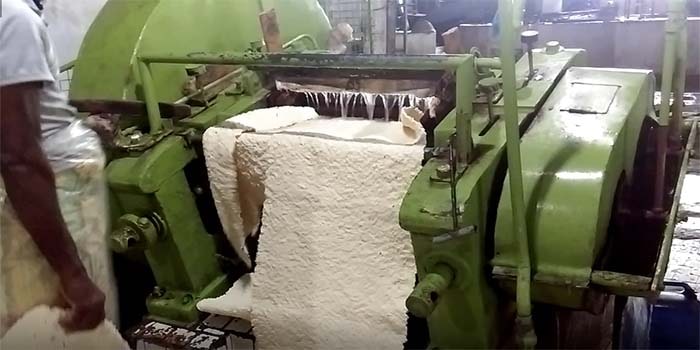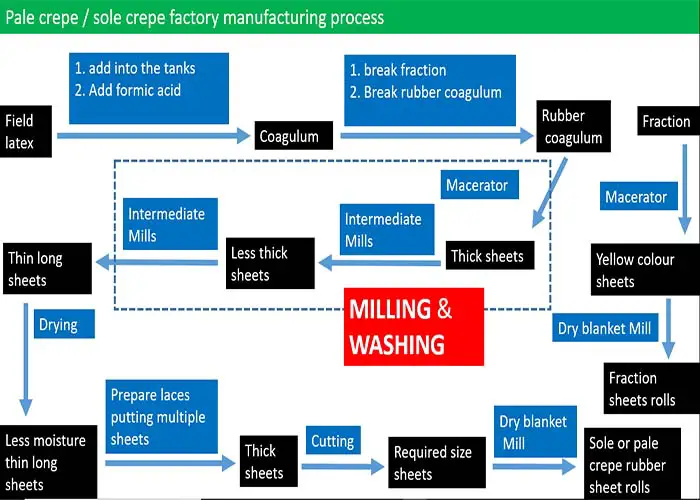Sole, pale crepe rubber manufacturing Process
Crepe rubber is manufactured by field rubber latex. There are many different grades of crepe rubber in the market. According to the grade, price of sheets vary. Also price of crepe rubber vary with time to time according to the demand. In crepe rubber manufacturing process, It needs machinery works to produce crepe rubber sheets and this process consumes lot of water. Constituents of rubber latex and chemicals are accumulated in water when crepe rubber is manufactured. Therefore crepe rubber manufacturing plant should have a water water treatment plant to clean waste water before water releasing to the natural environment.
Grades of crepe rubber
Grades of crepe rubber depends on quality of crepe rubber sheets. Also quality of sheets depends on several factors such as quality of latex, amount of formic acid adding, , coagulation time, washing quality ( using more water in the milling section can make higher grade crepe ), drying time.
- Latex Crepe No.1X
- Latex Crepe No.1
- Latex Crepe No.2
- Latex Crepe No.3
- Latex Crepe No.4
- Scrap Crepe (Brown) No.1
- Scrap Crepe (Brown) No.2
- Scrap Crepe (Brown) No.3
- Scrap Crepe
- (Brown) No.4
- Flat Bark and Skim Crepe
Crepe Rubber Manufacturing
Crepe rubber manufacturing is long process. It takes around 4 days to finish one bulk of sheets. Crepe rubber should be manufactured very cleanly, because they are used to prepare pharmaceutical products. usually crepe rubber takes white colour. As much as non rubber constitutes should be removed to get more clean and pure crepe rubber. Cleanest and pure rubber will get higher price in the market.

Fig 01: a milling machine in the factory. Rubber sheets are sent through two rollers and each of rubber sheets are washed very well.
Types of crepe rubber
- Pale crepe
- Sole crepe
- Skim crepe rubber
Latex crepe is white colour and high solubility.Pale crepe is used in non black applications and vulcanized pale crepe has excellent tack, green and hot tear strengths.
Pale crape does not contain any leachable chemicals. Hence rubber's natural protein level is decreased to minimum level.
Field latex should have following requirements to manufacture pale crepe.
What is pale crepe rubber?
Pale crepe is the default crepe manufacturing in the factory. It's dry rubber percentage is lower (due to more non-rubber content) than sole crepe and thickness is higher than sole crepe. Also pale crepe manufacturing, it goes less number of milling operations compared to the sole crepe. Pale crepe is manufactured as a part in sole crepe production or pale crepe is manufacturd directly. Pale crepe is used to manufacture shoes toes which are more used in cold conditions.
What is sole crepe rubber?
Sole crepe is much pure than pale crepe because sole crepe includes very less amount of non-rubber partcles. Reason for that is, more milling and washing operations are applied to sole crepe. Due to more washing non rubber partcles are washed out. Sole crepe is more white than pale crepe. Sole crepe is used to manufacture pharmaceutical instruments. Sole crepe factory needs more milling machines and labours.
Requirements of latex to manufacture pale crepe
- Free from yellow pigments
- Should not have a marked tendency to undergo enzymatic discolouration.
- free from amines or other compounds which can dark the final pale crepe.
- Should have a reasonable hardness after processing to crepe form.
Raw materials for Crepe Rubber
- Field latex
- Sodium sulphite - Sodium sulphite is the best anticoagulant for crepe rubber manufacturing. If ammonia is used it will discolour the resultant crepe rubber
- Fresh clean water
- Bleaching agents - Oil bases tolyl mercaptam (RRI-7) was used past. This has been modified to water soluble agents and 4 different trades are currently using, Nexobleach new formula, Rupepa, RPA-4 and polybleach.
- Coagulants: Formic acid, oxalic acid are used (partly or entirely) when hardness of water in processing is high.
- Washing soda (Na2CO3) to remove acids remaining in the rolls.
Process of Crepe Rubber Manufacturing
- Field latex is collected and strained by multiple passes through sieves of different mesh sizes to remove dirt.
- Field latex is collected into bulking tanks.
- Sodium bisulphite or sodium metabisulphite is added to prevent enzymatic discolouration in pale crepe rubber.
- Next standardization of rubber is done. Latex is diluted to DRC 15%.
- Then fractionation is done by 2 processes. First obtain the yellow fraction and next white fraction. Add sodium bisulphite.
- When fractionation was finished, latex is flown to coagulation tanks.
- Bleaching agents are added in the coagulation tank.
- Bleaching agent - Oil bases tolyl mercaptam (RRI-7) was used past. This has been modified to water soluble agents and 4 different trades are currently using, Nexobleach new formula, Rupepa, RPA-4 and polybleach.
- Next, coagulants (Formic acid) are added and latex should be stirred for several minutes. With that formed froth is removed.
- After that coagulum is removed and processed into different grades.
- Then milling is applied according to the grades. Some grades are listed below.
- Blanket crepe rubber
- Thin lace rubber
- Sole crepe rubber
- Rollers should be washed every day and wipe the rollers with a cloth soaked in a dilute solution of washing soda to remove any acid remaining in the rollers. Then rollers should be rinsed to remove any washing soda and dried.
- Next, sheets are dried in a room. Drying is usually done at 340C for two to three days. In drying period moisture content of rubber sheets is reduced. If drying is not done properly, defects may occur in sheets later.
- Then, laces are prepred by dried sheets. Several dried sheets are put on together and send through a mill. Rollers of these mills are smaller than Macerator, Intermediate and smoth mills. Also when preparing laces, sheets are not washed by water.
- After, preparing laces, they are cut into required sizes.
- Some of prepared sheets are sent to dry blanket mill.
Defects of crepe rubber
Discolouration of crepe rubber
Discolouration is the main defects of crepe rubber. Discolouration may happen from 2,3 days to 3-4 months after manufacturing crepe rubber. Occurence of metal ions in the crepe rubber sheets is the main reason for discolouration. In washing, these metal ions should be washed out as possible as. But some metal ions will remain if washing is not done properly.
Differences between pale crepe and sole crepe
Both of pale crepe (sometimes called as crepe) and sole crepe are manufactured in a similar way. In crepe rubber manufacturing number of passes through the mills are very important.
- Sole crepe is send more passes through mills. Therefore thickness of sole crepe is less than pale crepe.
- Example: 13 passes for sole crepe and 7 passes for pale crepe.
- Sole crepe is more cleaner than pale crepe because sole crepe is used to manufacture pharmaceuticals items.
- Sole crepe is more white than pale crepe. Sole crepe is washed more during in manufacturing process. Therefore, its non rubber constituents (proteins, lipids, sugar, inorganic ions) are removed. These proteins may cause to discolouration of crepe rubber. Eliminating those non-rubber constituents will add more value to crepe rubber

Fig 02: Factory process of manufacturing crepe rubber.
Crepe rubber factory manufacturing process video
Crepe rubber production is a long process which has many unit operationsin a factory. Dilluting the latex, letting coagulating, breaking coagulationn, milling the coagulation and washing preparing sheets ,drying and cutting are process in the factoriesThis video was uploaded on: 18/03/2018
Still have a Question? Ask your question now. We will help you
Is there any method to accelerate the process of fractionation in crepe rubber manufacturing process?
Asked by: Charuka Malshan
You can add excess weak acids (Mostly formic acid) to accelarate the fractionation process. But this should be done very accurately. Otherwise, milling and next processes will be hard to do fractionation is over done.
This tutorial was published on : 04/12/2017
Writer: Heshan Nipuna, Department of Chemical and Process Engineering, University of Preadeniya